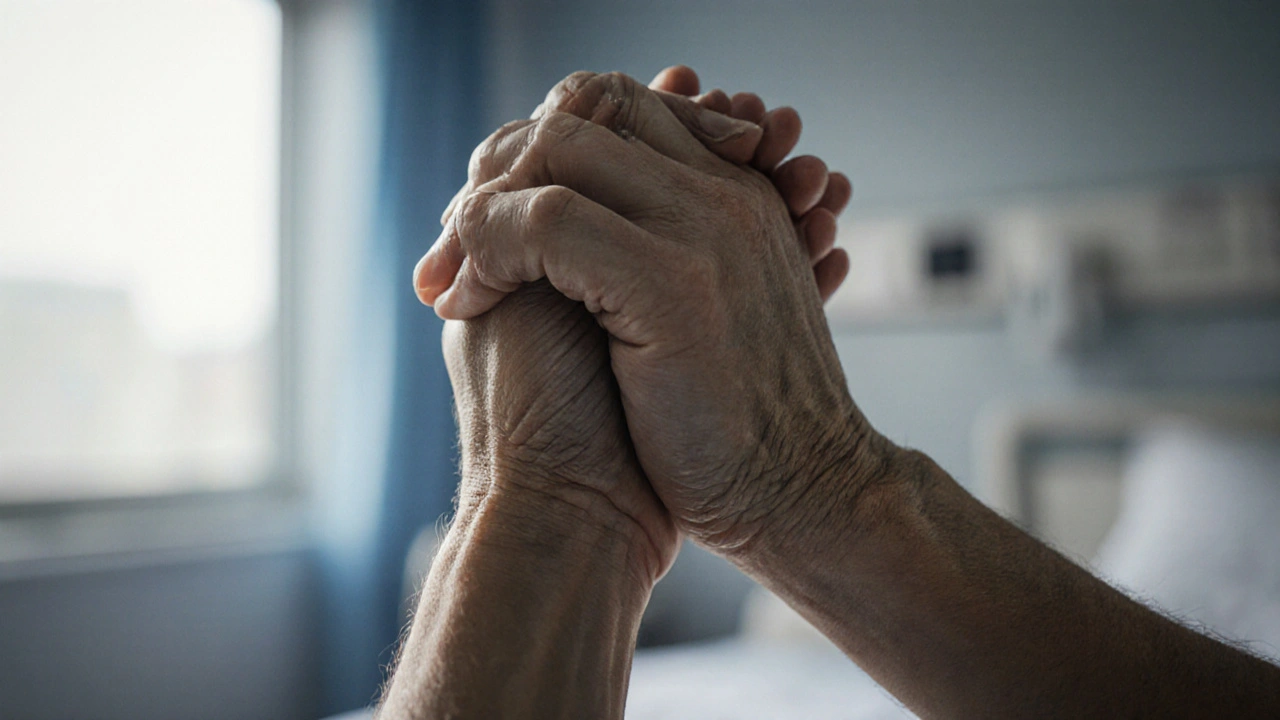The Healing Power of Touch: How Human Contact Heals Body and Mind
 Nov, 15 2025
Nov, 15 2025
When was the last time you held someone’s hand just because they needed it? Not to fix something, not to give advice-just to be there? That simple act isn’t just kind. It’s medicine.
Touch Isn’t Just Comfort-It’s Biology
Your body doesn’t distinguish between a hug from a loved one and a massage from a therapist. Both trigger the same chain reaction: skin receptors send signals to your brain, your nervous system shifts from fight-or-flight to rest-and-digest, and your body releases oxytocin-the bonding hormone. Cortisol, the stress chemical, drops. Heart rate slows. Blood pressure follows.
A 2023 study from the University of Auckland tracked 120 people receiving five minutes of gentle hand-holding during a medical procedure. Those who were touched had 37% lower cortisol levels and reported 52% less anxiety than those who weren’t. This isn’t placebo. It’s measurable physiology.
Even premature babies in NICUs show faster weight gain and improved sleep when held skin-to-skin. The World Health Organization recommends kangaroo care as standard practice-not because it’s sentimental, but because the data proves it saves lives.
Therapeutic Touch: More Than Just Massage
Therapeutic touch isn’t just about muscles and knots. It’s about restoring rhythm. When someone’s body has been in chronic pain or emotional shock, their nervous system gets stuck. Touch helps reset it.
Practitioners of therapeutic touch use light, non-invasive hand movements over the body, without pressure. It’s not massage. It’s not energy work in the mystical sense. It’s a structured technique grounded in biofield science. Trained therapists report improved outcomes in chronic pain, PTSD, and even post-surgical recovery when touch is part of the protocol.
At the Wellington Regional Hospital, nurses trained in therapeutic touch saw a 28% reduction in opioid use among post-op patients over six months. Patients didn’t just feel better-they needed fewer drugs. That’s not magic. That’s neuroscience.
Why We Fear Touch-And Why We Need It More Than Ever
We live in a world that’s never been more connected and yet more physically distant. Screens replace hugs. Texts replace handshakes. We’ve been taught to guard our space, to avoid contact that might be misread.
But loneliness isn’t just sad-it’s deadly. A 2024 meta-analysis in The Lancet found that chronic loneliness increases risk of early death by 29%, comparable to smoking 15 cigarettes a day. Touch is one of the few antidotes.
Think about it: when you’re upset, what’s the first thing you do? You reach for someone. You grab their arm. You lean into them. You don’t text. You don’t email. You touch.
That instinct is hardwired. We evolved in groups. We survived because we held each other. Denying touch doesn’t make us stronger. It makes us weaker.

How to Use Touch Safely and Effectively
Not all touch is healing. Bad touch-forceful, rushed, or unwanted-can do harm. Healing touch requires presence, consent, and intention.
- Ask first. Even with loved ones. "Can I hold your hand?" is more powerful than just doing it.
- Slow down. A five-second hug with full attention does more than a ten-second one while scrolling on your phone.
- Use your hands, not your agenda. Don’t touch to fix. Touch to connect.
- Respect boundaries. Some people have trauma. Some cultures avoid touch. Always honor that.
For caregivers, partners, or anyone supporting someone in pain, simple practices make a difference:
- Place a hand gently on their shoulder while they speak.
- Brush their hair back with your fingertips.
- Hold their foot while they rest.
- Offer a warm hand to hold during a difficult moment.
These aren’t gestures. They’re interventions.
When Touch Isn’t Enough-And What to Do About It
Touch isn’t a cure-all. It won’t heal broken bones or reverse cancer. But it can make the journey bearable. It can reduce the weight of suffering.
People with chronic illness often say the hardest part isn’t the pain-it’s the isolation. A hand on the back during chemo. A foot rub after a long day. A quiet moment of skin-to-skin contact with a child who’s scared.
That’s where touch becomes essential. It says: "You’re not alone. I’m here. You matter."
For those without access to trained therapists or supportive relationships, even self-touch helps. Placing both hands over your heart for 60 seconds. Gently massaging your temples. Wrapping your arms around yourself. These actions activate the same calming pathways in your nervous system.

The Ripple Effect of Healing Touch
One touch doesn’t just help one person. It changes the whole system.
When a parent holds their crying child, the child calms. The parent relaxes. The household tension drops. A coworker who receives a supportive pat on the shoulder feels seen. They’re more likely to help someone else later.
Healing touch creates ripples. It builds resilience. It strengthens communities. It reminds us we’re not meant to be islands.
In a world that values productivity over presence, choosing to touch-gently, respectfully, intentionally-is a radical act. It’s not soft. It’s strong. It’s necessary.
What You Can Do Today
You don’t need training. You don’t need permission. You just need to begin.
- Reach for someone’s hand today-not to fix, not to talk, just to hold.
- Give a 10-second hug to someone you care about. No words. Just presence.
- Put your hand on your own chest for one minute. Breathe. Feel your heartbeat.
- If you’re a caregiver, add one minute of intentional touch to your daily routine.
Healing doesn’t always come from a pill or a procedure. Sometimes, it comes from the quiet, steady warmth of a human hand.
Can touch really reduce physical pain?
Yes. Studies show that gentle, intentional touch activates the brain’s pain-relief pathways. It triggers endorphin release and reduces activity in the areas of the brain that process pain signals. In clinical settings, patients receiving therapeutic touch report measurable drops in pain scores-even when no medication is used.
Is therapeutic touch the same as massage?
No. Massage works on muscles and connective tissue using pressure and movement. Therapeutic touch uses light, non-contact hand movements over the body’s energy field, based on biofield science. It doesn’t require undressing or physical manipulation. It’s often used in hospitals for patients who can’t tolerate pressure.
What if I’m not comfortable with touch?
That’s completely valid. Many people have trauma, cultural reasons, or sensory sensitivities that make touch difficult. Healing doesn’t require physical contact. You can still benefit from presence-sitting quietly with someone, speaking softly, or offering a warm drink. The goal is connection, not contact. Always honor your boundaries.
Can I learn therapeutic touch without being a professional?
Yes. Many hospitals and community health centers offer free workshops on basic therapeutic touch for caregivers and family members. You don’t need certification to hold someone’s hand with care. The key is intention, not technique. Simple, slow, present touch is powerful.
Does touch help with anxiety and depression?
Yes. Oxytocin released through touch lowers stress hormones and increases feelings of safety and trust. In clinical trials, people with moderate depression who received weekly therapeutic touch sessions showed improved mood scores after four weeks-comparable to some antidepressants, without side effects. It’s not a replacement for therapy, but it’s a powerful support.
